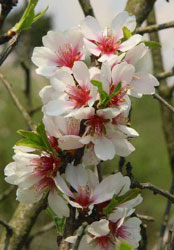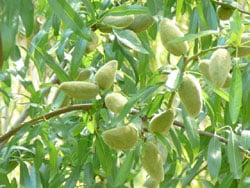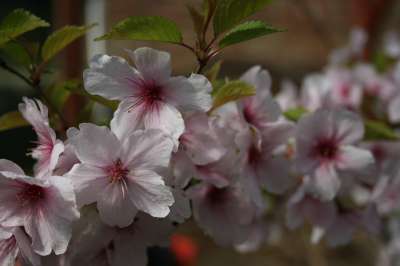Your basket is currently empty!
Tips and Recommendations for Growing Your Almond Tree
The classic almond tree can boast dual reasons for it’s cultivation. Not many trees can claim this…. So it’s worth ensuring a few ground rules are in place before planting one in your garden.
Often thought of as a blossom tree – but equally often sought after for it’s delicious nuts. The bouquets of scented rich pink blossom appear in early Spring. The deliciously sweet and oily nuts are ripe late in the Autumn, emerging from furry capsules that look like small peaches, to which this tree is closely related.
Although general cultivation is reasonably straightforward, to get the best from an almond you need to give careful consideration to siting, for this isn’t a tree you can plant just anywhere and expect it to thrive.

SITING
First and foremost it really likes a climate that is warmer than the UK weather can often can give. Which isn’t to say it’s not hardy – it is – but if you plant an almond in a consistently cold or damp environment it will sulk and never reveal it’s true beauty or value.
Lots of sunshine is key here. The more hours of sunshine the better. But soil also plays a crucial role of course. It needs good drainage because poorly drained or heavy soils are colder and less aerated. A good fertile reasonably retentive loam is ideal and a situation sheltered from north or easterly winds a huge advantage.
One of the reasons for this is that this is one of the earliest flowering of all trees, the rose pink blossoms usually open in early March. This makes them more vulnerable to spring frosts which turns them brown. This will not only mar their beauty, but it also reduces or eliminates the crop of nuts for that Autumn as well. Colder or shadier aspects are also less likely to be favoured by the pollinating insects necessary to provide good blossom set.
An almond tree can do well in an orchard setting in more favoured areas. A site in the centre of the orchard is often more advantageous because the tree can gain some protection from surrounding trees. It is also possible to fan train against a wall; this must be south facing. You will need a space not less than a little over 2 metres high and wide.
SIZE & ROOTSTOCKS
Almond trees can grow quite vigorously and in this country on St Julien stock will grow to 15’ or so, or a little less depending on the situation. As these are quite upright trees the spread is usually a little less than the height. Sometimes they are grafted on to Brompton stock which will make a tree rather more than that, but on our nursery we only use the St Julien rootstock. They aren’t compatible with todays dwarfing rootstocks and are usually budded or grafted onto St Julien or Brompton stocks. It is usually feasible to keep the tree on St Julien to 10’ or so with regular judicious pruning. Trimming the new growths in late Summer is usually better than resorting to heavy pruning every 2-3 years. Trees grown in a container will achieve rather less growth,.
SOIL PREPARATION FOR ALMOND TREES
Make sure you have a good 20” of well cultivated top soil in which to plant. This should be well dug over and friable – not cloddy – and incorporating well rotted leafmould or lawn clippings will help, as will a generous application of bonemeal mixed into the soil mix. It is beneficial if possible to prepare the site a few weeks in advance of planting to allow it all to settle before planting.
PLANTING THE ALMOND TREE
Planting is best undertaken from November to February as a bare rooted tree when the tree is dormant. A dormant tree suffers less transplant shock and will leaf up happily later in it’s first Spring. If necessary you can plant a container grown tree from late Spring to the Summer. This can be an advantage in colder areas where establishment can take place before the trees first winter.
Set the bare rooted tree in a hole just large enough to take the roots without bending or cramping, and infill with the prepared soil. Firm down well with the heal of your boot so there are no air pockets underground which could cause the roots to dry out. Water it in to settle the soil around the roots. Planting at this time of year should remove the necessity to water again until the first Spring – if it is a dry one it is a good idea to observe the tree regularly and give it some water if the new leaves appear stressed or droopy.
A container grown tree should be set so the top of the compost is level with the surrounding soil. Firm it in well and water heavily. Continue to water well, applying at the base of the tree, daily for the first 3-4 weeks or until well established. The tree will probably be dependant on watering for the entire first summer. The cooler nights of Autumn should reduce the necessity for regular watering.
Staking is a good idea for the first year or two, although seldom required permanently. Insert a 1×1”hardwood tree stake at planting time and secure with a rubber tree tie.
Mulch the tree after planting with compost or fine chipped bark. This will conserve moisture and also suppress weed growth which might otherwise compete with the tree as it establishes.
GROWING IN CONTAINERS
Although not the most ideal tree for container growing, it is possible if you can acquire a large half barrel or similar. This should be filled with John Innes no 3 loam based compost, or something similar. Planting should follow the guidelines for that given above and remember that the container grown tree will always be dependant on you for all it’s nutrients and water. Watering most days from April to September will be a necessity. You can top dress each season with growmore or bonemeal to provide the nutrients necessary for healthy growth. Be sure to site the container in a warm sunny spot – near to a warm wall is ideal.
PRUNING THE ALMOND TREE
This is along similar lines to an apple tree but winter pruning is preferred. Having planted a young tree it should be cut back by one third to promote a bushy shape. A new leader will form the first summer. Any lower branches can also be removed to create a clear trunk. In subsequent years prune to promote a fairly open centre; older trees often develop dead or unproductive wood. Don’t be afraid to prune back to viable new growth which will then take over.
POLLINATION
Almonds are self fertile so there are no pollination issues and just one tree will crop on it’s own.
HARVESTING
How exciting to pick your first crop of beautiful sweet nuts in their furry capsules! You should wait until late October before harvesting. Often when the capsules start to split open this is a good sign that the nuts are ripe. At this stage the flavour will have fully developed. The fruiting capsules can be dried on a sunny windowsill and after a further 2-3 weeks t should be possible to easily extract the nuts themselves.

DISEASES
Almonds, as well as their close relative the Peach and Nectarine, suffer from two maladies. One is canker the other is leaf curl. The latter is the most likely to be encountered and is quite prevalent alas. It is quite unmistakeable as the leaves blister and curl in an alarming manner. The other issue we have with leaf curl is that the only effective chemical remedy was withdrawn from use and is no longer available. Really the only solution therefore is to pick off the infected leaves as they form in the Spring. Usually the new growth will come clean by early summer. Giving the tree a liquid feed at ground level at this time will help and encourage it to shrug off the leaf curl and promote stronger new growth. You can also snip off the growing tips of heavily infected growths. They will soon shoot again from just below the cut.
Cankerous growths are best removed completely at source.
VARIETIES OF ALMOND TREE
There is only a limited selection. The original Prunus dulcis is the most commonly offered for sale and continues to provide good results. It is the moist attractive tree with lovely flowers.
Robijn is a continental selection with improved quality and yield.
Ingrid is a newer variety that is said to have better disease resistance and is proving to be a popular introduction already.
Almonds often have a relatively short life span of around 10 years. This can be dependent on soil and location. If you need to re-plant make sure this is in a different area and not in the same soil as the original tree.



